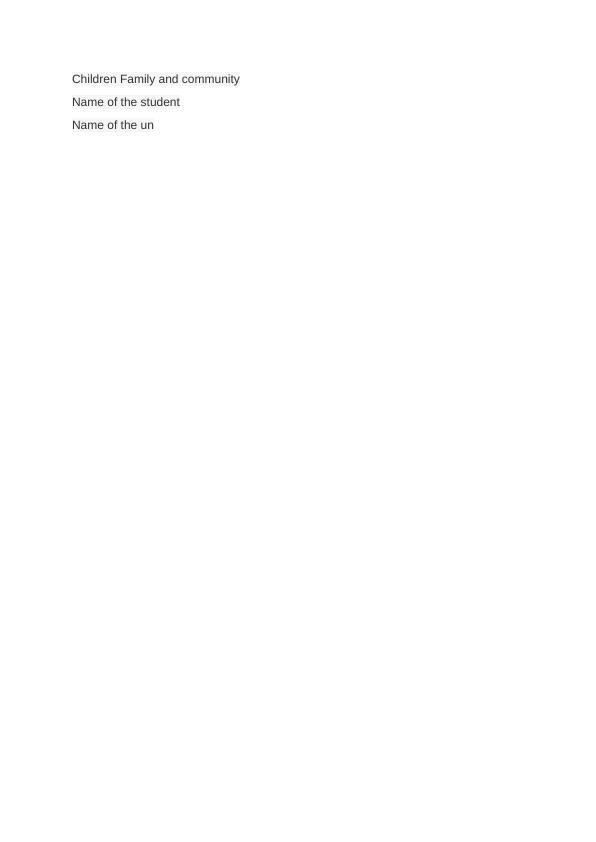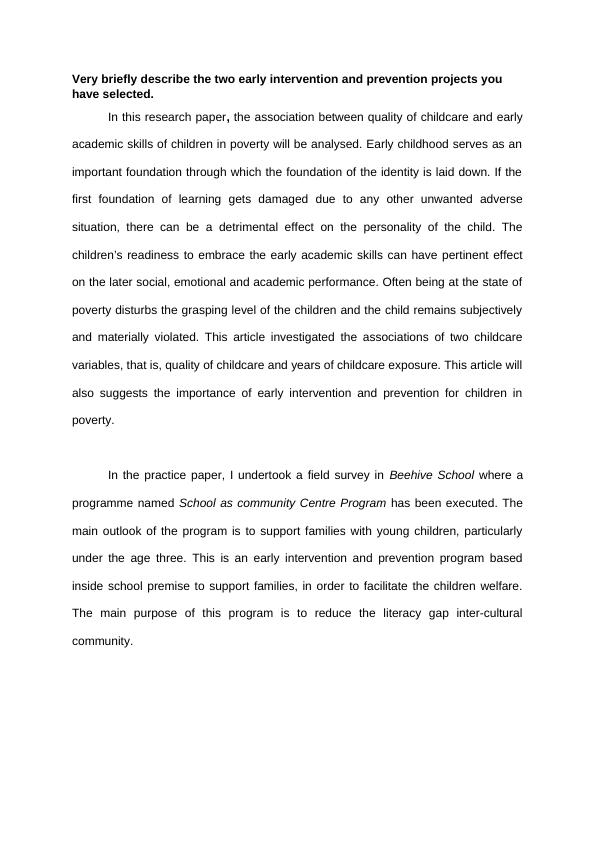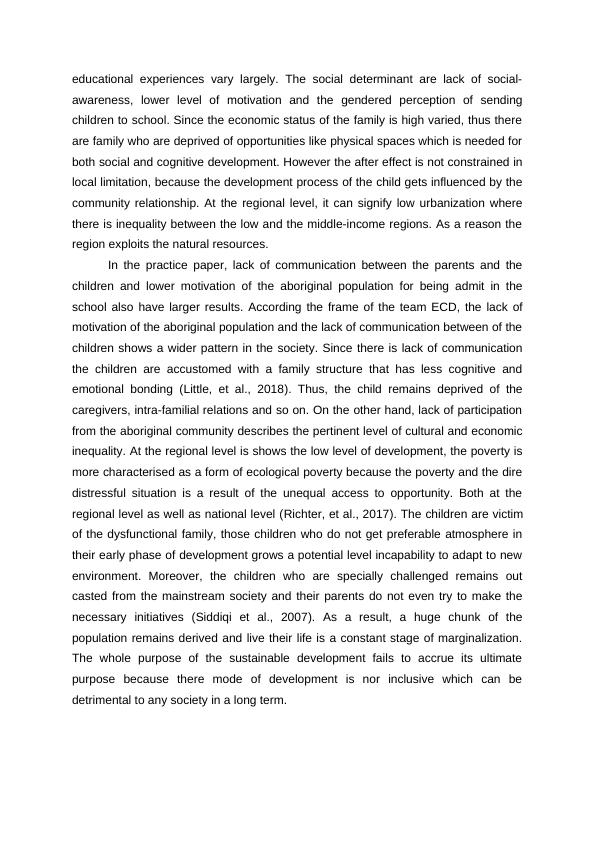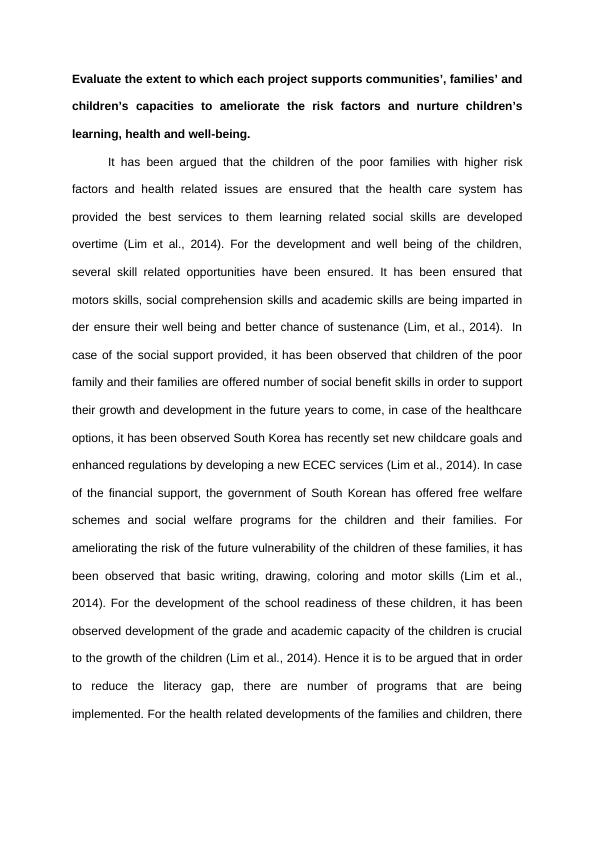Early Intervention and Prevention Projects for Children in Poverty
Added on 2023-01-18
23 Pages7614 Words61 Views

Children Family and community
Name of the student
Name of the un
Name of the student
Name of the un

Very briefly describe the two early intervention and prevention projects you
have selected.
In this research paper, the association between quality of childcare and early
academic skills of children in poverty will be analysed. Early childhood serves as an
important foundation through which the foundation of the identity is laid down. If the
first foundation of learning gets damaged due to any other unwanted adverse
situation, there can be a detrimental effect on the personality of the child. The
children’s readiness to embrace the early academic skills can have pertinent effect
on the later social, emotional and academic performance. Often being at the state of
poverty disturbs the grasping level of the children and the child remains subjectively
and materially violated. This article investigated the associations of two childcare
variables, that is, quality of childcare and years of childcare exposure. This article will
also suggests the importance of early intervention and prevention for children in
poverty.
In the practice paper, I undertook a field survey in Beehive School where a
programme named School as community Centre Program has been executed. The
main outlook of the program is to support families with young children, particularly
under the age three. This is an early intervention and prevention program based
inside school premise to support families, in order to facilitate the children welfare.
The main purpose of this program is to reduce the literacy gap inter-cultural
community.
have selected.
In this research paper, the association between quality of childcare and early
academic skills of children in poverty will be analysed. Early childhood serves as an
important foundation through which the foundation of the identity is laid down. If the
first foundation of learning gets damaged due to any other unwanted adverse
situation, there can be a detrimental effect on the personality of the child. The
children’s readiness to embrace the early academic skills can have pertinent effect
on the later social, emotional and academic performance. Often being at the state of
poverty disturbs the grasping level of the children and the child remains subjectively
and materially violated. This article investigated the associations of two childcare
variables, that is, quality of childcare and years of childcare exposure. This article will
also suggests the importance of early intervention and prevention for children in
poverty.
In the practice paper, I undertook a field survey in Beehive School where a
programme named School as community Centre Program has been executed. The
main outlook of the program is to support families with young children, particularly
under the age three. This is an early intervention and prevention program based
inside school premise to support families, in order to facilitate the children welfare.
The main purpose of this program is to reduce the literacy gap inter-cultural
community.

– Identify the ways in which your selected focus ’area of vulnerability’ might
influence children’s development,
In the research paper, the early child prevention measures are initiated to
overcome the situation of dire poverty. According to the studies, it is seen that the
boys are found to be vulnerable to poverty and lack the social-skills to learn or adapt
new things. Viewing from an ecological point of view, people who are poverty-
stricken are at the receiving end and thus can be exploited when there is an
ecological crisis (Little, et al., 2018). However, there is a gender dimension to it,
because according to this study the boys are at a high-risk rather the girls. Boys are
more vulnerable than girls and they are also left at the environmental exposure than
girls. The research project aim to use ECEC program that will initiate a
compensatory and proactive education for the disadvantage children.
In practice project, the area of vulnerability is not targeting the any particular
section of population. As I have interviewed, I got to know that the program is also
trying to bridge up the gap by addressing the children who are specially abled such
as autism or speech defect. The area of vulnerability of this practice paper is to
bridge the communication gap between the children and the parents because that is
the utmost problem where the parents fail to take adjudicate care of their children.
Kids tend to spend more time in electronic device and they are not willing to come to
school. This has become a great problem, where the child is deprived of emotional
care from their family member. The concern of this Early Prevention and Intervention
program has also extended their reach to children who come from the vulnerable
section and also from the specially disabled group.
Critically analyse and compare the two projects using Siddiqi, Irwin and
Hertzman’s TEAM-ECD framework (2007).
According to the assessment model of Early Child Development as suggested
by the World Health Organization, the social determinants of health along with the
larger environmental concerns will be gauged in the ECD period of the child (World
Health Organization. 2017).
In the research paper, the main concern is to help the children who are in a poverty-
stricken condition. According to this research, it has been noted that the quality of
the childcare provided to the children is widely varied, thus it implies that uneven
influence children’s development,
In the research paper, the early child prevention measures are initiated to
overcome the situation of dire poverty. According to the studies, it is seen that the
boys are found to be vulnerable to poverty and lack the social-skills to learn or adapt
new things. Viewing from an ecological point of view, people who are poverty-
stricken are at the receiving end and thus can be exploited when there is an
ecological crisis (Little, et al., 2018). However, there is a gender dimension to it,
because according to this study the boys are at a high-risk rather the girls. Boys are
more vulnerable than girls and they are also left at the environmental exposure than
girls. The research project aim to use ECEC program that will initiate a
compensatory and proactive education for the disadvantage children.
In practice project, the area of vulnerability is not targeting the any particular
section of population. As I have interviewed, I got to know that the program is also
trying to bridge up the gap by addressing the children who are specially abled such
as autism or speech defect. The area of vulnerability of this practice paper is to
bridge the communication gap between the children and the parents because that is
the utmost problem where the parents fail to take adjudicate care of their children.
Kids tend to spend more time in electronic device and they are not willing to come to
school. This has become a great problem, where the child is deprived of emotional
care from their family member. The concern of this Early Prevention and Intervention
program has also extended their reach to children who come from the vulnerable
section and also from the specially disabled group.
Critically analyse and compare the two projects using Siddiqi, Irwin and
Hertzman’s TEAM-ECD framework (2007).
According to the assessment model of Early Child Development as suggested
by the World Health Organization, the social determinants of health along with the
larger environmental concerns will be gauged in the ECD period of the child (World
Health Organization. 2017).
In the research paper, the main concern is to help the children who are in a poverty-
stricken condition. According to this research, it has been noted that the quality of
the childcare provided to the children is widely varied, thus it implies that uneven

educational experiences vary largely. The social determinant are lack of social-
awareness, lower level of motivation and the gendered perception of sending
children to school. Since the economic status of the family is high varied, thus there
are family who are deprived of opportunities like physical spaces which is needed for
both social and cognitive development. However the after effect is not constrained in
local limitation, because the development process of the child gets influenced by the
community relationship. At the regional level, it can signify low urbanization where
there is inequality between the low and the middle-income regions. As a reason the
region exploits the natural resources.
In the practice paper, lack of communication between the parents and the
children and lower motivation of the aboriginal population for being admit in the
school also have larger results. According the frame of the team ECD, the lack of
motivation of the aboriginal population and the lack of communication between of the
children shows a wider pattern in the society. Since there is lack of communication
the children are accustomed with a family structure that has less cognitive and
emotional bonding (Little, et al., 2018). Thus, the child remains deprived of the
caregivers, intra-familial relations and so on. On the other hand, lack of participation
from the aboriginal community describes the pertinent level of cultural and economic
inequality. At the regional level is shows the low level of development, the poverty is
more characterised as a form of ecological poverty because the poverty and the dire
distressful situation is a result of the unequal access to opportunity. Both at the
regional level as well as national level (Richter, et al., 2017). The children are victim
of the dysfunctional family, those children who do not get preferable atmosphere in
their early phase of development grows a potential level incapability to adapt to new
environment. Moreover, the children who are specially challenged remains out
casted from the mainstream society and their parents do not even try to make the
necessary initiatives (Siddiqi et al., 2007). As a result, a huge chunk of the
population remains derived and live their life is a constant stage of marginalization.
The whole purpose of the sustainable development fails to accrue its ultimate
purpose because there mode of development is nor inclusive which can be
detrimental to any society in a long term.
awareness, lower level of motivation and the gendered perception of sending
children to school. Since the economic status of the family is high varied, thus there
are family who are deprived of opportunities like physical spaces which is needed for
both social and cognitive development. However the after effect is not constrained in
local limitation, because the development process of the child gets influenced by the
community relationship. At the regional level, it can signify low urbanization where
there is inequality between the low and the middle-income regions. As a reason the
region exploits the natural resources.
In the practice paper, lack of communication between the parents and the
children and lower motivation of the aboriginal population for being admit in the
school also have larger results. According the frame of the team ECD, the lack of
motivation of the aboriginal population and the lack of communication between of the
children shows a wider pattern in the society. Since there is lack of communication
the children are accustomed with a family structure that has less cognitive and
emotional bonding (Little, et al., 2018). Thus, the child remains deprived of the
caregivers, intra-familial relations and so on. On the other hand, lack of participation
from the aboriginal community describes the pertinent level of cultural and economic
inequality. At the regional level is shows the low level of development, the poverty is
more characterised as a form of ecological poverty because the poverty and the dire
distressful situation is a result of the unequal access to opportunity. Both at the
regional level as well as national level (Richter, et al., 2017). The children are victim
of the dysfunctional family, those children who do not get preferable atmosphere in
their early phase of development grows a potential level incapability to adapt to new
environment. Moreover, the children who are specially challenged remains out
casted from the mainstream society and their parents do not even try to make the
necessary initiatives (Siddiqi et al., 2007). As a result, a huge chunk of the
population remains derived and live their life is a constant stage of marginalization.
The whole purpose of the sustainable development fails to accrue its ultimate
purpose because there mode of development is nor inclusive which can be
detrimental to any society in a long term.

Evaluate the extent to which each project supports communities’, families’ and
children’s capacities to ameliorate the risk factors and nurture children’s
learning, health and well-being.
It has been argued that the children of the poor families with higher risk
factors and health related issues are ensured that the health care system has
provided the best services to them learning related social skills are developed
overtime (Lim et al., 2014). For the development and well being of the children,
several skill related opportunities have been ensured. It has been ensured that
motors skills, social comprehension skills and academic skills are being imparted in
der ensure their well being and better chance of sustenance (Lim, et al., 2014). In
case of the social support provided, it has been observed that children of the poor
family and their families are offered number of social benefit skills in order to support
their growth and development in the future years to come, in case of the healthcare
options, it has been observed South Korea has recently set new childcare goals and
enhanced regulations by developing a new ECEC services (Lim et al., 2014). In case
of the financial support, the government of South Korean has offered free welfare
schemes and social welfare programs for the children and their families. For
ameliorating the risk of the future vulnerability of the children of these families, it has
been observed that basic writing, drawing, coloring and motor skills (Lim et al.,
2014). For the development of the school readiness of these children, it has been
observed development of the grade and academic capacity of the children is crucial
to the growth of the children (Lim et al., 2014). Hence it is to be argued that in order
to reduce the literacy gap, there are number of programs that are being
implemented. For the health related developments of the families and children, there
children’s capacities to ameliorate the risk factors and nurture children’s
learning, health and well-being.
It has been argued that the children of the poor families with higher risk
factors and health related issues are ensured that the health care system has
provided the best services to them learning related social skills are developed
overtime (Lim et al., 2014). For the development and well being of the children,
several skill related opportunities have been ensured. It has been ensured that
motors skills, social comprehension skills and academic skills are being imparted in
der ensure their well being and better chance of sustenance (Lim, et al., 2014). In
case of the social support provided, it has been observed that children of the poor
family and their families are offered number of social benefit skills in order to support
their growth and development in the future years to come, in case of the healthcare
options, it has been observed South Korea has recently set new childcare goals and
enhanced regulations by developing a new ECEC services (Lim et al., 2014). In case
of the financial support, the government of South Korean has offered free welfare
schemes and social welfare programs for the children and their families. For
ameliorating the risk of the future vulnerability of the children of these families, it has
been observed that basic writing, drawing, coloring and motor skills (Lim et al.,
2014). For the development of the school readiness of these children, it has been
observed development of the grade and academic capacity of the children is crucial
to the growth of the children (Lim et al., 2014). Hence it is to be argued that in order
to reduce the literacy gap, there are number of programs that are being
implemented. For the health related developments of the families and children, there

End of preview
Want to access all the pages? Upload your documents or become a member.
Related Documents
Gender Discrimination and Early Childhood Education in Australialg...
|10
|2620
|89
Intervention Plan for Children's Wellbeing in a Case Studylg...
|12
|3197
|181
Childcare Interaction With Justicelg...
|9
|2867
|12
Introduction to Sociology PDFlg...
|8
|529
|269
CHILDREN FAMILIES AND COMMUNITIES.lg...
|4
|476
|67
Report on Benefits of Role Playing in Child Learninglg...
|3
|452
|78